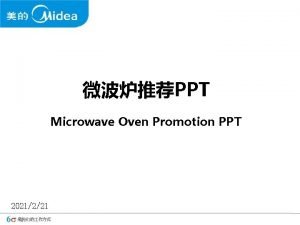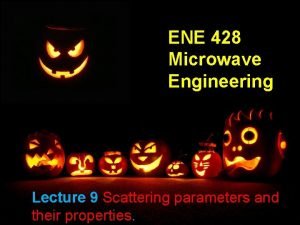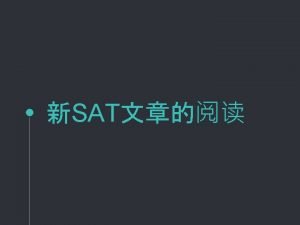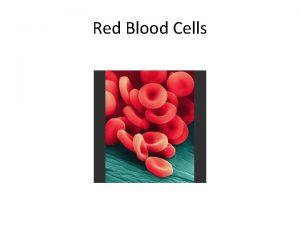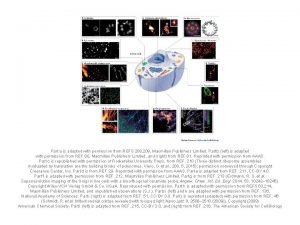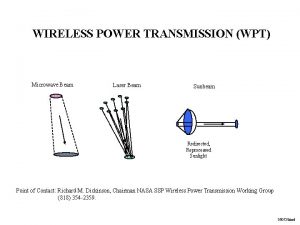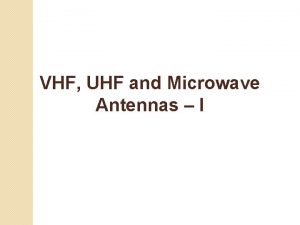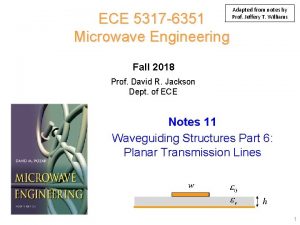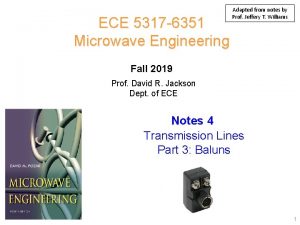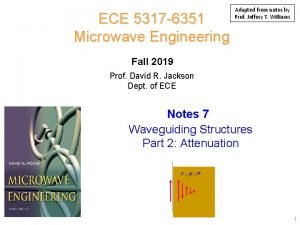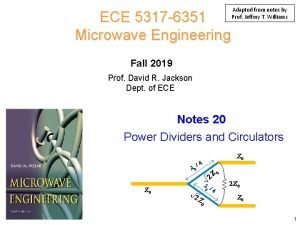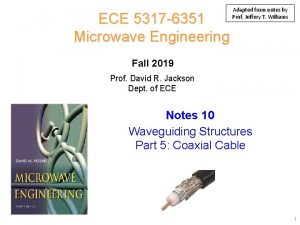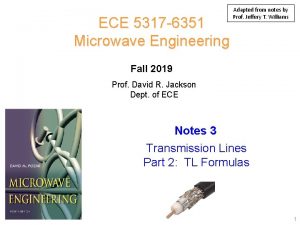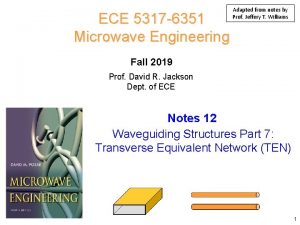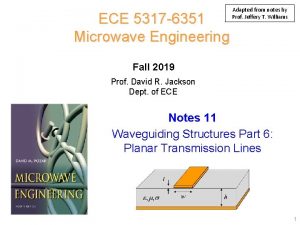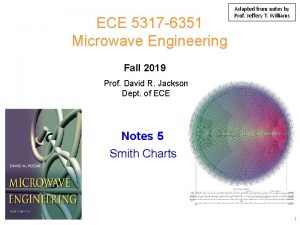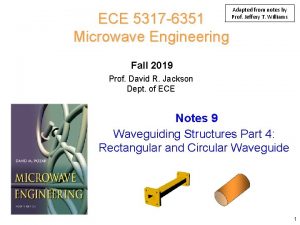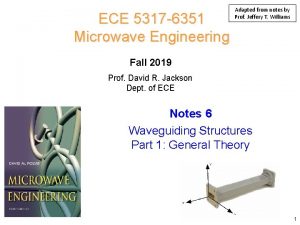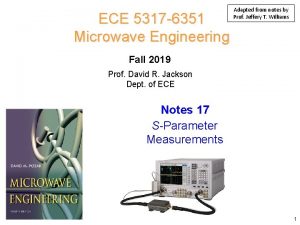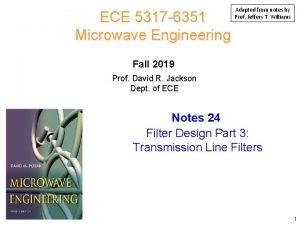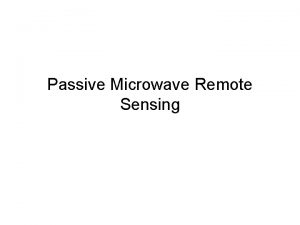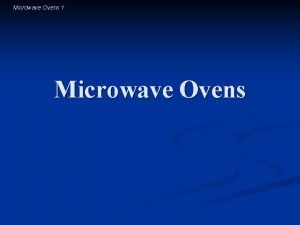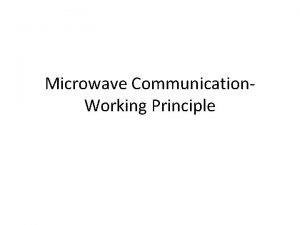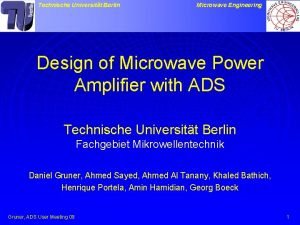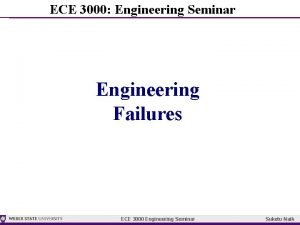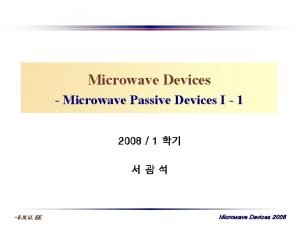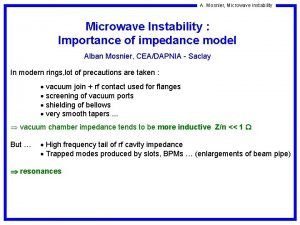ECE 5317 6351 Microwave Engineering Adapted from notes

































- Slides: 33

ECE 5317 -6351 Microwave Engineering Adapted from notes by Prof. Jeffery T. Williams Fall 2019 Prof. David R. Jackson Dept. of ECE Notes 21 Quadrature Coupler and Rat-Race Coupler 1

Quadrature (90 o) Coupler “A quadrature coupler is one in which the input is split into two signals (usually with a goal of equal magnitudes) that are 90 degrees apart in phase. Types of quadrature couplers include branchline couplers (also known as quadrature hybrid* couplers), Lange couplers and overlay couplers. ” Taken from “Microwaves 101” http: //www. microwaves 101. com/encyclopedia/Quadrature_couplers. cfm This coupler is very useful for obtaining circular polarization: There is a 90 o phase difference between ports 2 and 3. Note: The term “hybrid” denotes the fact that there is an equal (3 d. B) power split to the output ports. 2

Quadrature Coupler (cont. ) 2 1 90 o Coupler 4 3 § The quadrature hybrid is a lossless 4 -port (the S matrix is unitary ). § All four ports are matched. § The device is reciprocal (the S matrix is symmetric. ) § Port 4 is isolated from port 1, and ports 2 and 3 are isolated from each other. 3

Quadrature Coupler (cont. ) The quadrature coupler is usually used as a splitter: 2 1 90 o Coupler 4 +90 o out of phase 2 - 3 = 90 o -90 o out of phase 2 - 3 = -90 o 3 Note: A matched load is usually placed on port 4. § The signal from port 1 splits evenly between ports 2 and 3, with a 90 o phase difference. Can be used to produce right-handed circular polarization. § The signal from port 4 splits evenly between ports 2 and 3, with a -90 o phase difference. Can be used to produce left-handed circular polarization. 4

Quadrature Coupler (cont. ) Branch-Line Coupler A microstrip realization of a quadrature hybrid (branch-line coupler) is shown here. Notes: § We only need to study what happens when we excite port 1, since the structure is physically symmetric. § We use even/odd mode analysis (exciting ports 1 and 4) to figure out what happens when we excite port 1. An analysis of the branch-line coupler is given in the Appendix. 5

Quadrature Coupler (cont. ) Summary The input power to port 1 divides evenly between ports 2 and 3, with ports 2 and 3 being 90 o out of phase. Note: A matched load is usually placed on port 4. 6

Quadrature Coupler (cont. ) A coupled-line coupler is one that uses coupled lines (microstrip, stripline) with no direct connection between all of the ports. Please see the Pozar book for more details. Port 1 Port 2 Port 3 Port 4 This coupler has a 90 o phase difference between the output ports (ports 2 and 3), and can be used to obtain an equal (-3 d. B) power split or another split ratio. 7

Quadrature Coupler (cont. ) Circularly-polarized microstrip antennas can be fed with a 90 o coupler. One feed port produces RHCP, the other feed port produced LHCP. Note: This is a better way (higher bandwidth) to get CP than with a simple 90 o delay line. 8

Rat-Race Ring Coupler (180 o Coupler) “Applications of rat-race couplers are numerous, and include mixers and phase shifters. The rat-race gets its name from its circular shape, shown below. ” Taken from “Microwaves 101” http: //www. microwaves 101. com/encyclopedia/ratrace_couplers. cfm Photograph of a microstrip ring coupler Courtesy of M. D. Abouzahra, MIT Lincoln Laboratory 9

Rat-Race Coupler (cont. ) 2 1 180 o Coupler 4 3 § The rat race is a lossless 4 -port (the S matrix is unitary). § All four ports are matched. § The device is reciprocal (the S matrix is symmetric). § Port 4 is isolated from port 1, and ports 2 and 3 are isolated from each other. 10

Rat-Race Coupler (cont. ) The rat race can be used as a splitter: 2 1 In phase 180 o Coupler 4 180 o out of phase 3 Note: A matched load is usually placed on port 4. § The signal from the “sum port” (port 1) splits evenly between ports 2 and 3, in phase. This could be used as a power splitter (alternative to Wilkinson). § The signal from the “difference port” (port 4) splits evenly between ports 1 and 2, 180 o out of phase. This could be used as a balun. 11

Rat-Race Coupler (cont. ) The rat race can be used as a combiner: 2 1 Signal 1 (V 1) 180 o Coupler 4 3 Signal 2 (V 2) § The signal from the sum port (port 1) is the sum of the input signals 1 and 2. § The signal from the difference port (port 4) is the difference of the input signals 1 and 2. 12

Rat-Race Coupler (cont. ) A microstrip realization is shown here. An analysis of the rat-race coupler is given in the Appendix. 13

Magic T A waveguide realization of a 180 o coupler is shown here, called a “Magic T. ” “Magic T” Note: Irises are usually used to obtain matching at the ports. IEEE Microwave Theory and Techniques Society Note the logo! 14

Monopulse Radar Rat-Race couplers are often used in monpulse radar. Input from B Four antennas Input from C Input from A Input from D Rat-Race: https: //www. microwaves 101. com/encyclopedias/monopulse-comparator-networks 15

Monopulse Radar (cont. ) The difference signals are used to determine the azimuth and elevation of the target. The difference between the two antenna signals maps into the phase difference , which maps into the angle . https: //www. microwaves 101. com/encyclopedias/monopulse-comparator-networks 16

Appendix A Here we analyze the quadrature coupler. Port 1 Excitation “even” analysis Input admittance of open-circuited stub: 17

Appendix A (cont. ) Port 1 Excitation “odd” problem Input admittance of short-circuited stub: 18

Appendix A (cont. ) Consider the general case: . In general: Shunt load on line Quarter-wave line 19

Appendix A (cont. ) Hence we have: 20

Appendix A (cont. ) Continuing with the algebra, we have: 21

Appendix A (cont. ) Hence we have: Convert this to S parameters (use Table 4. 2 in Pozar): Note: We are describing a two-port device here, in the even and odd mode cases. This is a 2 2 matrix, not a 4 4 matrix. 22

Appendix A (cont. ) Adding even and odd mode cases together: Hence By symmetry: 23

Appendix A (cont. ) By symmetry and reciprocity: 24

Appendix A (cont. ) By symmetry and reciprocity: 25

Appendix A (cont. ) By symmetry and reciprocity: 26

Appendix B Here we analyze the Rat-Race Ring coupler. Layout Schematic 27

Appendix B (cont. ) Port 1 Excitation “even” problem 28

Appendix B (cont. ) Port 1 Excitation “odd” problem 29

Appendix B (cont. ) Proceeding as for the 90 o coupler, we have: 30

Appendix B (cont. ) Converting from the ABCD matrix to the S matrix, we have: Note: We are describing a two-port device here, in the even and odd mode cases. This is a 2 2 matrix, not a 4 4 matrix. Use Table 4. 2 in Pozar 31

Appendix B (cont. ) For the S parameters coming from port 1 excitation, we then have: 32

Appendix B (cont. ) Similarly, exciting port 2, and using symmetry and reciprocity, we have the following results (derivation omitted): 33
 Microwave remote sensing lecture notes
Microwave remote sensing lecture notes 2021221
2021221 Scattering matrix of a reciprocal network is
Scattering matrix of a reciprocal network is This passage is adapted from jane austen
This passage is adapted from jane austen How is a red blood cell adapted
How is a red blood cell adapted Adapted with permission from
Adapted with permission from In what ways have the highland maya adapted to modern life?
In what ways have the highland maya adapted to modern life? Xerophytic adaptations
Xerophytic adaptations Chaparral biome location
Chaparral biome location Camel adaptations for survival
Camel adaptations for survival Adapted animals in the rainforest
Adapted animals in the rainforest Best brother quotes
Best brother quotes Adapted from the internet
Adapted from the internet Gallant
Gallant How have plants adapted to the rainforest
How have plants adapted to the rainforest Spermopsida plants
Spermopsida plants The outsiders adapted for struggling readers
The outsiders adapted for struggling readers Sustained synoynm
Sustained synoynm Behavioral adaptations of zebras
Behavioral adaptations of zebras Conversion notes brutes en notes standard wisc 5
Conversion notes brutes en notes standard wisc 5 Sustainable engineering ktu syllabus
Sustainable engineering ktu syllabus Illumination engineering notes pdf
Illumination engineering notes pdf Financial engineering notes
Financial engineering notes Software engineering lecture notes
Software engineering lecture notes A conical shaped recess around a hole
A conical shaped recess around a hole Foundation engineering lecture notes
Foundation engineering lecture notes Engineering economics and management
Engineering economics and management Design process notes
Design process notes Descriptive ethics
Descriptive ethics Microwave wpt
Microwave wpt Vhf uhf and microwave antennas
Vhf uhf and microwave antennas Microwave diathermy block diagram
Microwave diathermy block diagram Solar power satellites and microwave power transmission
Solar power satellites and microwave power transmission Microwave circuit simulation software
Microwave circuit simulation software

